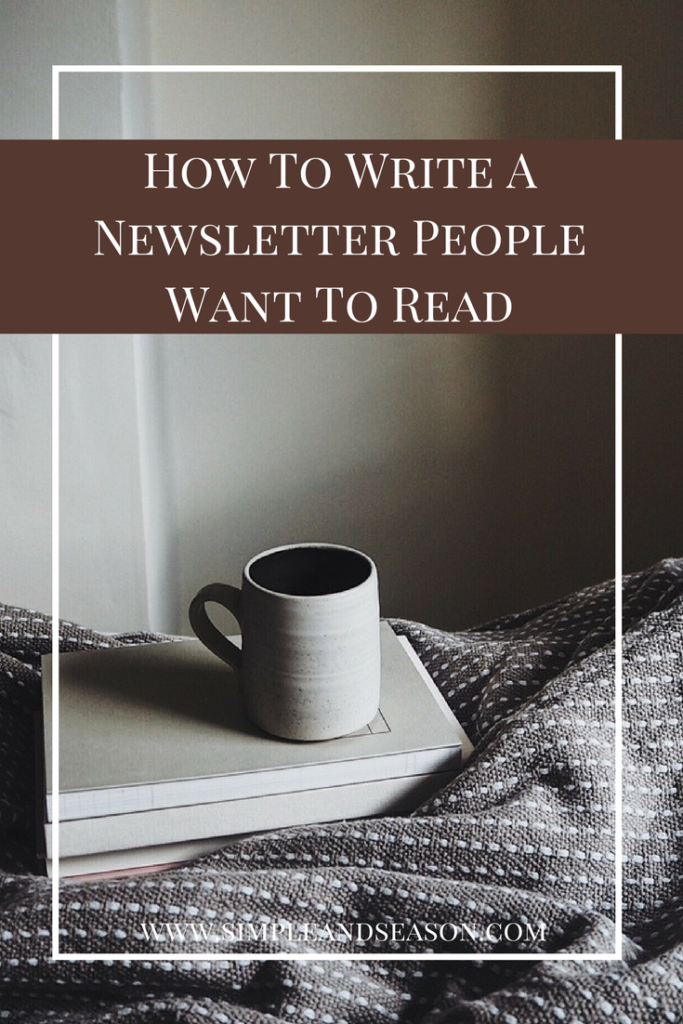How To Write An Email Newsletter People Want To Read
Email marketing is having a Renaissance. A few years ago we all thought it was on its way out, as most of us as consumers frankly hated it. Brands would bombard inboxes multiple times a day, email scams were rife and grabbing headlines and emails just seemed to be adding to all the noise. But now, thanks to legislation, more sophisticated spam filters and marketers developing the craft, the email newsletter is back, and regularly touted on creative business blogs and podcasts as ‘the one thing you must 100% definitely absolutely be doing’.
Quite often I debunk these ‘must-dos’, but I’m very much on this particular bandwagon. There are lots of reasons why email is great – getting sign ups allows you to take control of the relationship with your customers, ending over-reliance on the social media platforms and enabling you to be proactive rather than hoping they find you again. It’s rare someone will buy from you the very first time they see your name, so giving you their email address is something they can do, and means you take responsibility for making sure they come back to buy.
However, there is still a hangover from those days of bad email marketing. People are protective of their inboxes, and protective of their data. They only want to sign up for a mailing list if they trust it, and if it justifies their attention on a weekly or monthly basis. Now the trust comes with how you show up in your business – a professional looking site, consistency of posting across all social media, generally not being dodgy. However, justifying their attention is a different story.
In this post, I’m going to cover some email marketing best practice and give you some ideas to start thinking about your own newsletter, and how to make it something people actually want to receive.
A Newsletter Is No Place For News
This is the first rule of newsletter club. The reason that as consumers we started opening up our inboxes to marketing emails again is because they gave us something we cared about, and, as hard as it is to say, your subscribers probably don’t care about your news. They want to receive things that help them, that give them value, that entertain or inspire them – if they get that they might tolerate your news, but it’s not the reason they’re there.
Think about your own email habits. What are the newsletters you look forward to, that you always open and actually read? What do they all have in common? I’m going to bet it’s not a business talking about themselves the whole way through. And when you see that little subscription box on a website asking you to ‘sign up to hear all our latest news!’, does that feel like an enticing proposition to you? Or does it make you ask ‘why?’.
So this is the first thing we need to get out of our heads when building a newsletter – it’s not about news, it’s about value.
What Do They Care About?
Ok great, but what’s valuable? Now you’re at even more of a loss of what to make your newsletter about, right? Knowing what’s valuable to your audience comes down to just knowing your audience – when you know what they struggle with, or what they want to make happen in their lives, it becomes a lot easier.
Here are a few ways to think about this:
What always stands out to customers about what you do? In other words, what gets the big exciting reaction from people? Perhaps, in a service-based business, it’s an a-ha moment that comes from a particular part of your process. If you make soaps it might be when you speak to people at fairs about your ingredients, or if you have a shop maybe it’s when people see how you put things together. That’s where the value is – now draw out how you can replicate this value across an email series
Ask your customers! This is definitely the easiest way – either via a traditional survey, or usually just an Instagram caption will do. Ask what they’d like to read in a monthly email from you. I’m trying to think of something to say that makes this sound more clever, but it’s just as simple as that.
What are others doing? Subscribe to the mailing lists of businesses that resonate with you, of those with similar audiences – most of the marketing emails we get are from M&S and Tesco and that can cloud what we think we should do. Look at what elements of other’s newsletter are successful and think about how you can apply that to your business. You may also find it helpful to subscribe to the emails of businesses you don’t particularly like – knowing what we definitely don’t want to be can be really helpful in thinking about what we do want to be. Just remember to unsubscribe afterwards.
For me, I know that my audience likes education, things they can tangibly use in their business, and some inspiration. So my newsletter has free resources from around the web, hashtags, a monthly challenge and a creative prompt. There is a little something for everyone, and the emails can be kept and looked back on weeks or months later. They are as useful a piece of content as any of my blog posts – because that’s what’s valuable to you guys. Maybe your audience wants to see pretty pictures of your house – great, do that.
How Personal Should I Be?
This is a question that comes up in my client calls about email, and the answer is that it really depends on your business. If you are a service provider, then a lot of what your customers buying is you, and a relationship with you. So introducing more of your personality across your brand will be important. If yours is not a personal brand, then it would clang a little for your newsletter to suddenly be really frank and vulnerable.
Compared to Instagram posts, blog content and other channels, however, in email you can afford to be more personal. The subscriber has opened themselves up and invited you into their inner sanctum, their inbox, so it is fitting that you match their vulnerability with your content. Plus, someone who signs up to your list is already interested in you and what you do; they gave you their email because they want to delve deeper and get to know the brand better.
With my own newsletter I surveyed my audience in an Instagram caption, and was surprised to hear that a substantial portion of them would like to read a personal letter from me (whereas I had been all about the useful, actionable value). So now I include a letter at the top of my emails, talking about my challenges that month, the lessons I’d learned and things I was proud of – this is part that always resonates with people and inspires most of the replies.I’m not saying you pour out your heart, I’m saying to find a way that your email and bring people closer to you and your brand. That could be a behind the scenes look at your product development, your meal plans for the week or a quote that resonated.



